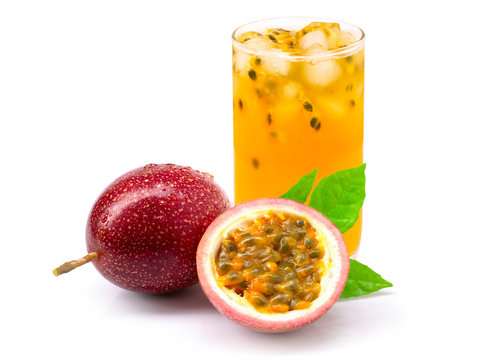If this summer you drank too much orange juice and were too fed up with that drink. If you really want a healthy and delicious alternative to orange juice, passion fruit juice is also a desirable choice.

Using a blender or not, learn how to produce your own homemade passion fruit juice, then tweak it to your tastes! This juice is loaded with vitamins, minerals, and antioxidants and is somewhat tart and sweet. It is also quite refreshing.
I frequently eat recipes with passion fruit, especially sweets. It’s now time to add homemade passion fruit juice to let the fruit’s natural sweet-tart flavor show. It’s ideal for sweltering summer days and whenever you want to indulge in tropical flavors!
Just the fruit, water, and a sweetener are needed to make this juice, making it incredibly easy to make. Additionally, there are other ways to modify the recipe, including adding extra ingredients. Additionally, you have complete control over the contents, so there are no unnecessary preservatives or excessive sugar levels!
Learn to produce your own passion fruit juice at home. This simple juice recipe (which you may personalize anyway you’d like) is vegan and low in sugar.
Passion fruit pairs well with a variety of flavors, including mango and pineapple. However, when you taste the antioxidant-rich passion fruit by itself, it truly shines. Nothing is more revitalizing than a cup of freshly squeezed juice. Although we aren’t technically squeezing the passion fruit, we still need to scoop out all of its sweetness.
When you don’t want to try new textures, homemade passion fruit juice is a terrific way to learn to like new flavors. Even while the seeds can be eaten, some people prefer not to eat them along with the pulp. Without actually using the seeds in our juice, we will make sure to remove all the golden deliciousness from them.
Passion fruit: What is it?
The fruit known as “passion fruit” is produced by the passion flower plant, which is indigenous to Brazil and northern Argentina. It is cultivated in a number of tropical and subtropical nations. The fruit is oval in shape and is officially a berry. possesses either deep purple (Passiflora edulis) or yellow skin, depending on the cultivar (Passiflora flavicarpa).
A juicy, golden-orange interior with a pulp that has a sweet-tart flavor is present. It also contains crispy black seeds that are excellent for juicing and adding to desserts.
The moniker “passion fruit” is merely one of the many names for this fruit. Other names include Granadilla, Lilikoi (in Hawaii), Maracuja or Maracuya (in Brazil/Ecuador), Chinola or Parchita (in Puerto Rico), and maybe others. I’ll use both names interchangeably in the following because of this.

Is consuming passion fruit juice healthy?
Vitamin C and A levels in passion fruit juice are very high. Both antioxidants will strengthen the immune system, reduce inflammation, and promote healthy skin.
A number of malignancies can have their risk reduced by antioxidants.
Carotenoids and polyphenols are abundant (the latter is more so than many other tropical fruits, like pineapple, mango, banana, etc.). These two powerful antioxidants also have anti-inflammatory properties.
has a moderate amount of iron, which is better absorbed because to the vitamin C in chinook juice. Making hemoglobin and transporting oxygen throughout the body depend on this.
The fruit has a low glycemic index (GI) rating, which means that eating it won’t cause a significant rise in blood sugar levels.
Potassium, which is found in maracuya juice, is crucial for heart health as well as the smooth operation of muscles and neurons.
reduced concentrations of magnesium, calcium, phosphorus, and vitamin B6 are present.
A single passion fruit has 2 grams of fiber, which is excellent for the digestive system, when the seeds are included.
The juice contains elements that have sedative-like properties, promoting restful sleep and reducing anxiety.
How to purchase passion fruit
The season for this fruit lasts from April through October. It is accessible during that time at numerous sizable supermarkets. However, you may also find it in a lot of foreign food markets and shops, like those in the African, Asian, and Caribbean regions.
You can also buy frozen passion fruit pulp or puree offline or online in several nations. Just make sure it says it’s 100% passion fruit on the label (no sweeteners, preservatives, etc.).

How do you tell when a passion fruit is ready to eat?
The best passion fruit is huge, hefty (meaning it has a lot of pulp), and firm. Avoid those that are excessively green and instead go for ones with a vivid hue (such as purple or yellow). Additionally, stay away from fruit that has dents, tiny holes, or noticeable soft places as these fruits may be moldy.
The skin is probably still unripe if it is smooth, and it is probably overripe if it is too wrinkled. The ideal level is when the skin is somewhat wrinkled but not excessively so. For the sweetest passion juice, if it isn’t quite ripe when you buy it, let it remain at room temperature (out of direct sunshine) until it wrinkles.
How Are Passion Fruits Cut?
By cutting off the top, I made mine crosswise. The juice, flesh, and seeds can all be obtained in this manner without creating a mess.
You can directly consume the flesh with a spoon. particularly if you can’t wait to try the delectable fruit. From stem to bottom, you can also cut it crosswise. To prevent the liquid and seeds from leaking, you must move quickly.
Manual process
Passion fruit juice requires little effort and can be made without a blender.
Pour the liquid from the passion fruit seeds into a fine-mesh filter or nut milk bag after transferring the pulp. To get as much liquid through the sieve as you can, squeeze the bag or crush it with the back of a spoon.
To make the maracuya drink, just combine the water and sweetener.
Blender technique
Even while it requires less time and work to prepare, this method of preparing passionfruit juice requires more cleanup.
Simply add the water, sugar, and fruit pulp to a blender or food processor. Pulse to help loosen the juice from around the seeds for 1-2 seconds at a time, being careful not to break up the seeds too much.
After that, pour the juice onto a fine-mesh strainer to remove the remaining seeds.
then savor the passion fruit beverage straight up. For a super-refreshing, homemade juice with a tropical flavor, serve it with ice and a few mint leaves. The juice can also be made into syrup, jelly, sorbet, or used to salad dressings, among other things.

In the refrigerator, how long does passion fruit juice last?
To get the most nutrients, consume the hydrating beverage right away. However, you can keep any leftovers in the fridge for 4-5 days if they are in a covered container (such as a pitcher, glass bottle, or mason jar/s). Before each serving, give it a thorough toss or shake because it can separate as it sits.
Juice from passion fruit can be frozen.
Absolutely. The Pasion fruit juice can be kept for up to 6 months in Ziplock bags or ice cube trays (then transferred to freezer bags). Then you can add some ice cubes to smoothies or lemonades. Alternately, defrost them first to use them in a cocktail or as juice.
Faqs
Are passion fruit seeds edible?
Absolutely. The portion of the passion fruit that can be eaten is the flesh and seeds within.
What to do with remaining peels from passion fruit?
This is a challenging one. I checked with a number of sources. Some people assert that purple passion fruit peels are inedible because they contain substances that can cause our bodies to produce cyanide.
However, there are recipes for jam and flour made from passion fruit peel that might work with yellow fruit. But I’d rather not consume them. Instead, you might use them as an organic “pot” for seedlings or make a natural color out of them.
What to do with any remaining seeds from passion fruit?
The drink made from passion fruit can still contain the crunchy seeds. Alternately, you may strain them out and eat them as snacks or throw them in the compost.
How can frozen pulp of passion fruit be made into juice?
Follow the procedures above after allowing the pulp to defrost. Simply diluted with water and sweetener if the puree is frozen and seedless. There is no need to strain or use a blender.
Above is all about passion fruit as well as the recipe for passion fruit juice. I hope it is useful to you and may you succeed in making passion fruit juice. Wishing you good health and luck.
